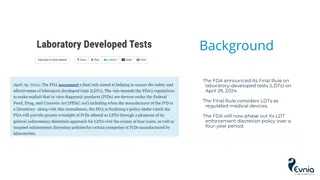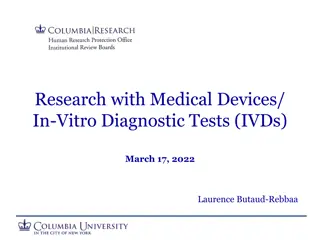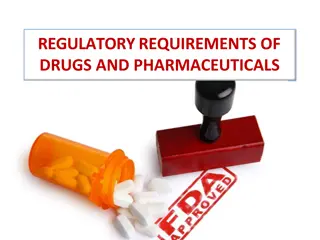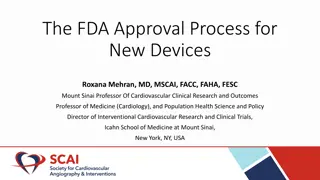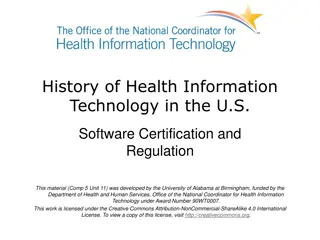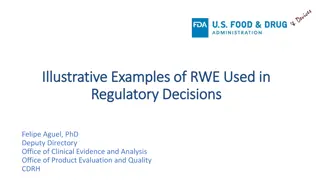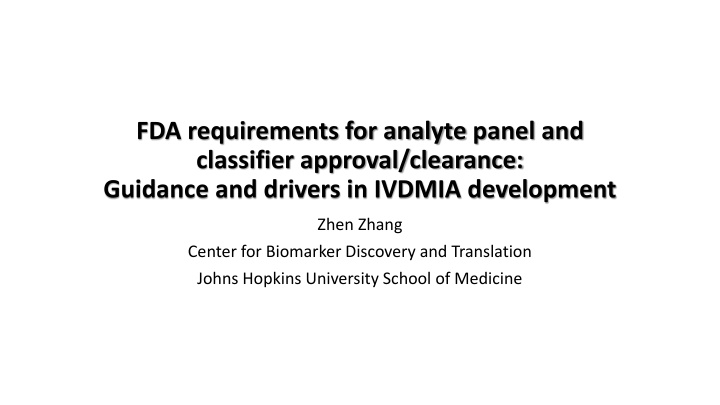
FDA Requirements for Analyte Panel and Classifier Approval/Clearance
This presentation delves into the FDA requirements for the approval and clearance of analyte panels and classifiers, focusing on guidance and drivers in IVDMIA development. It showcases the work of Dr. Zhen Zhang from the Center for Biomarker Discovery and Translation at Johns Hopkins University School of Medicine. The development process of FDA-cleared tests OVA1 and Overa is highlighted as an example, emphasizing the importance of meeting regulatory standards for safety and effectiveness in IVDMIA biomarker data classification models.
Download Presentation

Please find below an Image/Link to download the presentation.
The content on the website is provided AS IS for your information and personal use only. It may not be sold, licensed, or shared on other websites without obtaining consent from the author. If you encounter any issues during the download, it is possible that the publisher has removed the file from their server.
You are allowed to download the files provided on this website for personal or commercial use, subject to the condition that they are used lawfully. All files are the property of their respective owners.
The content on the website is provided AS IS for your information and personal use only. It may not be sold, licensed, or shared on other websites without obtaining consent from the author.
E N D
Presentation Transcript
FDA requirements for analyte panel and classifier approval/clearance: Guidance and drivers in IVDMIA development Zhen Zhang Center for Biomarker Discovery and Translation Johns Hopkins University School of Medicine
Disclosure Through license agreements between Johns Hopkins University and Vermillion Inc., Dr. Zhen Zhang is entitled to royalty payment from OVA1 and Overa. The two FDA cleared tests OVA1 and Overa were developed partially supported by a sponsored research agreement between Vermillion Inc. and Johns Hopkins University and funding from DOD and NCI/EDRN. Clinical performance of the two tests will not be discussed. Only the process of development is used as an example for the presentation.
IVDMIA (per FDA) A device that 1. combines the values of multiple variables using an interpretation function to yield a single, patient-specific result (e.g., a classification, score, index, etc.), that is intended for use in the diagnosis of disease or other conditions, or in the cure, mitigation, treatment or prevention of disease, and 2. provides a result whose derivation is non-transparent and cannot be independently derived or verified by the end user.
Development of IVDMIA Biomarker data Classification model Clinical evaluation Study & Model derivation via machine learning experimental design Clinical Relevance Statistical Soundness Regulatory Requirements
Elements in regulatory requirements for safety and effectiveness drives IVDMIA development Intended use. Performance Characteristics Analytical performance Clinical studies: clinical sensitivity and specificity Clinical cutoffs.
A tests intended use is defined by the time point at which it is to be used along a disease process Early Detection Prognosis Predicting response to Tx Screening Risk Assessment Wellness? Monitoring
The time point-defined intended use in turns helps to define IVDMIA target population (inclusion/exclusion) and consider the following: If test is positive, what are the options for clinical intervention? Will it likely alter patient outcomes? What are the consequence for test false positive/false negative? What are the current alternatives in testing for this intended use? Availability of samples at this time-point under current gold standard Dx? Will a meaningful size of patient population benefit from the test? (potential commercial market size)
Design a tests desired performance characteristics Desired Test Performance High Sensitivity High Sensitivity & Specificity High Specificity OVA1 OCaScr Sizeof biomarker target population [Small] [large] Prevalence of phenotypein test population OVA1 OCaScr [High] [Low] OCaScr, OVA1 Consequence of false negative [Significant] [Insignificant] OVA1 OCaScr Consequence of false positive [Insignificant] [Significant] Zhang, Z., & Chan, D. W. (2010). Cancer epidemiology, biomarkers & prevention
Biplot of biomarkers in training data and tentative classifier in projected 2D space
Question: Many of the algorithms behind an IVDMIA is nonlinear which make it difficult to attribute a final IVDMIA score to the individual markers numerically. What evidence is needed for the inclusion of individual markers in an IVDMIA panel? Does each of the input markers need to demonstrate its own discriminatory power and if so at what level?
Cutoff and clinical performance characteristics 1.0 NPV Sensitivity (% of disease detected) 0.8 Performance Metrics Additional cases captured 0.6 Specificity 0.4 Enriched PPV over Prevalence PPV 0.2 Prevalence At cutoff=5.0AU, 38.0% of premenopausal samples were positive 0.0 0.0 0.2 0.4 0.6 0.8 1.0 Proportion of Test Positives
Question: What are the factors in deciding whether a single cutoff for positive/negative results or multiple cutoffs representing different bins of estimated probability of positive conditions is more appropriate?
MC estimated analytical performance characteristics of IVDMIA 9 8 7 %CV of IVDMIA 6 5 4 3 2 1 0 2 3 4 5 6 7 8 9 10 Mean IVDMIA
Center for biomarker discovery and translation Center for biomarker discovery and translation
Acknowledgement JHU Current: Daniel W Chan, Lori Sokoll,, Hui Zhang, Jin Song. Past: C Nicole Rosenzweig, Jinong Li, Alex Rai, Lily Chen, Bai Zhang. Collaborators on ovarian cancer biomarker research RC Bast, Jr., IJ Jacobs, A Berchuck, C Van Haaften-Day, NF Hacker, HW de Bruijn, AG van der Zee, F Ueland, R Bristow, ET Fung, D Munroe, S Skates. Funding: NCI/EDRN BRL (D Chan), BDL (Z Zhang), CPTAC (H Zhang, Z Zhang, D Chan), DOD (Z Zhang), and Vermillion Inc.
Questions repeated What evidence is needed for the inclusion of individual markers in an IVDMIA panel? Many of the algorithms behind an IVDMIA is nonlinear which make it difficult to attribute a final IVDMIA score to the individual markers numerically. Does each of the input markers need to demonstrate its own discriminatory power and if so at what level? What are the factors in deciding whether a single cutoff for positive/negative results or multiple cutoffs representing different bins of estimated probability of positive conditions is more appropriate. My presentation will show how our understanding of the regulatory requirement helps to shape our IVDMIA development process. We would like to hear FDA s comments whether our understand is correct and make sense, and if we missed important factors/items. The value of an input to a multivariate panel may be affected by factors external to an IVDMIA algorithm. How such changes could be periodically incorporated into an approved/cleared IVDMIA and what the type of evidence/data will be required.


